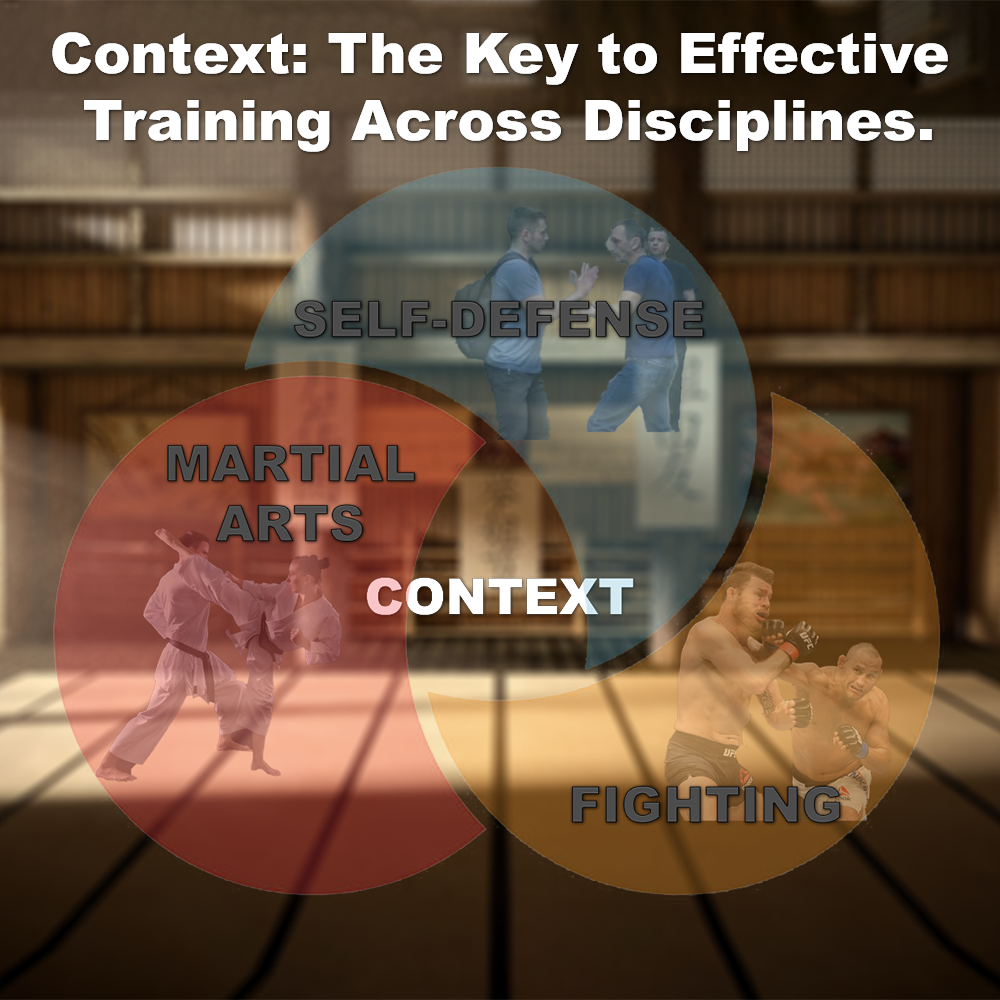
Context: The Key to Effective Training Across Disciplines.
Posted by ADAM CARTER on OCT 28, 2024

Context: The Key to Effective Training Across Disciplines.
(Approx 2 minute 45 second read)
I recently wrote a couple of articles about going to the ground in self-defense. Many of the comments said that you’d better know how to fight on the ground because most altercations end up there.
Yes, you may end up on the ground, and it’s imperative you drill both what to do there, and how to avoid it. However, to say that most altercations end up on the ground is simply not true.
This claim seems to have originated with the Gracies, who began promoting it in the late 1980s to support their BJJ. Unfortunately, the so-called “statistic” that 90% of all fights go to the ground is a myth. It’s unproven because no one has collected a representative sample to draw data from. Its original source wasn’t “all fights” but rather LAPD arrests.
The study specifically concerned “Use of Force” issues within the Los Angeles Police Department. The study found that when LAPD officers were arresting suspects it ended with one or both parties wrestling on the ground 62% of the time.
The number wasn’t 90%, it was 62%. And the context was law enforcement arrests – not a “fight,” and certainly not self-defense.
To claim that most or all fights end up on the ground is simply not true. Where’s the evidence? The burden of proof lies with those perpetuating this claim to validate it with solid data.
If you view available HAPV (Habitual Acts of Physical Violence) statistics, such as data from the British Crime Survey, and ER visit reports, they consistently show that the claim most fights end on the ground doesn’t hold up. Studies indicate that while ground-fighting can occur, most altercations begin with standing strikes or shoves and often end before they reach the ground.
The people who argue that altercations end up on the ground often favor their own training methods. But what many of them ignore is that purposely going to the ground doesn’t account for accomplices, weapons, the environment, and, most importantly, any loved ones who may be with you. If you go to the ground, what will you do for them?
The potential safety of loved ones should come before the need to defend your ego.
In challenging circumstances, we have to do the best we can, and that requires prior training and practice – including protecting others. If you’re on the ground trying to secure one person, where does that leave others you may need to protect? Protecting others is a critical part of self-defense.
Trying to achieve a hold, lock, or dominant position severely limits your ability to defend yourself or escape. Staying on your feet gives you mobility, a chance to disengage, escape, and protection from multiple attackers.
Going to the ground – it’s important to have training there – but it’s only one part of the whole, not the primary focus. Sport-based methods emphasize ground fighting because the context allows for it. In self-defense, the goal is survival, not achieving dominance on the ground.
Yes, it is generally accepted that a well-rounded martial artist should include some ground-fighting in their training. Training from varied positions has value, especially when preparing for the potential of being forced into a compromised position.
But we train most effectively when we clearly define the objective of that training, as I have tried to illustrate in the image above. However, in my view, many practitioners and instructors are unclear on what they are training for. That uncertainty leads to ineffective and unfocused training where it matters.
It’s useful for instructors to ensure their teaching is objective-driven, remaining clear on the purpose of their training, then there is no confusion about when any given method is applicable and when it isn’t.
Self-defense is about staying grounded in reality, not theatrics. Let’s stick with common sense – and understand the differences between the martial arts, fighting and self-defense.
Written by Adam Carter – Shuri Dojo.
![]() Photo Credit: inspired by Iain Abernethy’s Martial Map – LAPD stats from Journal of Non-lethal Combatives
Photo Credit: inspired by Iain Abernethy’s Martial Map – LAPD stats from Journal of Non-lethal Combatives
